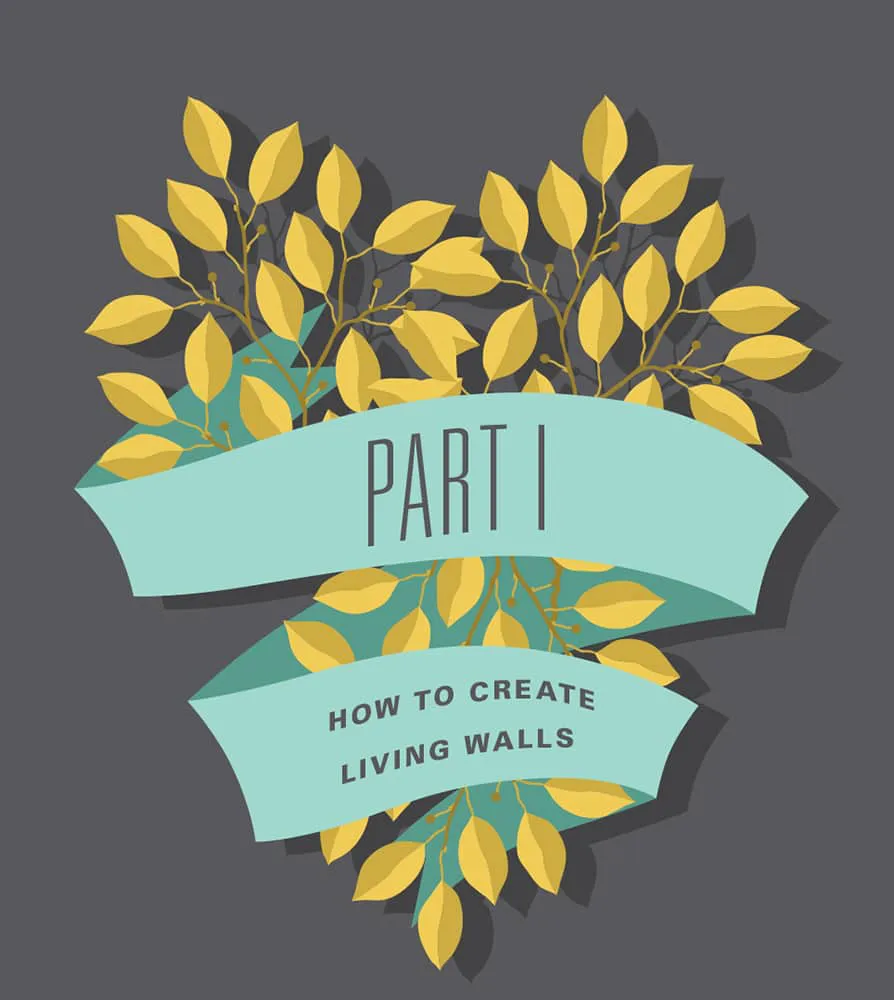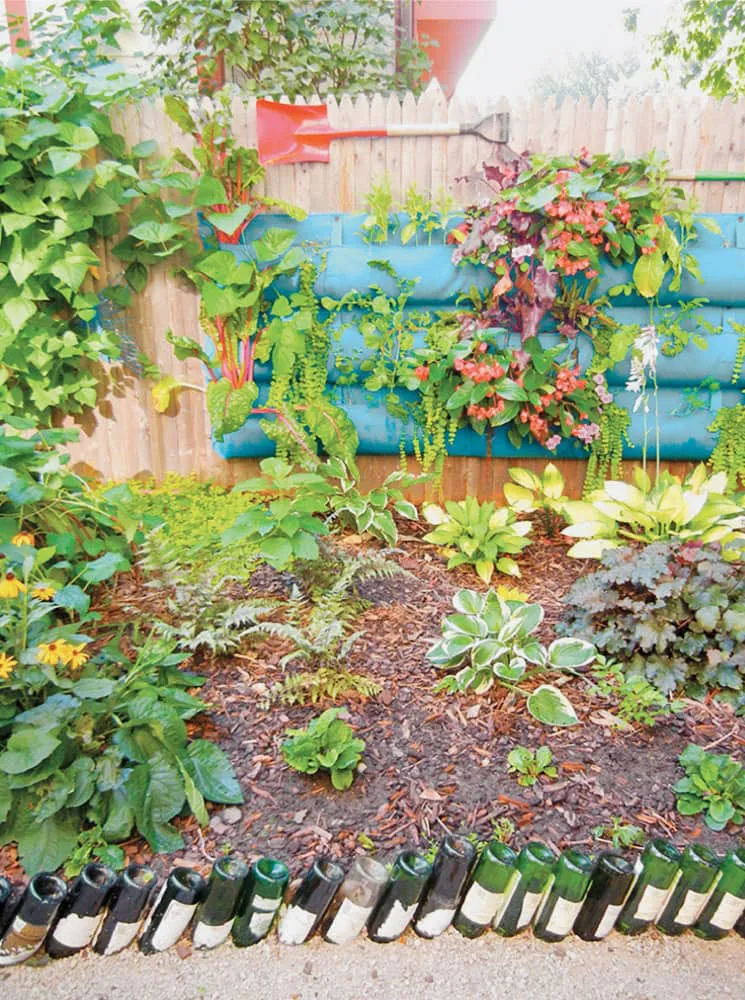![]()
Finding the right living wall system to fit your unique planting requirements will help you succeed at growing. This vista shows a shady, damp side yard filled with fern and moss living walls built for the local growing conditions. Learn how to grow a living wall before it is installed for the best success!
GETTING STARTED ON GROWING your first living wall is amazingly easy. Living wall gardens have a lot of the same needs as traditional container gardens. Therefore, succeeding with a living wall or vertical garden is as simple as choosing the right container, the right location, and the right plants. Having the ability to plant thirty-five to forty plants in an area that is less than 2 square feet offers an astounding amount of garden ideas for small space or urban growers.
Throughout this book you will see twenty-three complete living walls presented as individual gardening projects. Each wall is designed for a unique and specific purpose that goes beyond simply being beautiful. For example, one design will help you save energy by insulating walls and blocking heat. Other gardens are created to generate large quantities of food for you and your community. Versatility and practicality are two hallmarks of the living wall, and knowing why you want to grow a garden and for what purpose is as important as selecting the right system and plants.
Before we get to these creative designs, the following section will introduce you to the basic tools, materials, techniques, and know-how that you’ll need for any living wall project, regardless of its purpose or unique properties. You’ll find the information in the following six sections:
• Which Living Wall System Is Right for You?
• Tools That Help
• Getting Started
• Watering the Living Wall
• Soil and Compost
• Choosing and Obtaining Plants for Your Living Wall
![]()
WHICH LIVING WALL SYSTEM IS RIGHT FOR YOU?
THERE ARE MANY TYPES of living wall systems that you can utilize, and it is important to discover the living wall system that is right for you, your family, and your community. Several of these are “plug-and-play” products that are easily assembled; others are more homemade and are customized to your own wishes and standards. Choosing which type of system is best for you should be based on the size of the area where you plan to plant, the types of plants you are interested in, and the varying types of walls you have access to.
For many years, the term “green wall” meant that the roots of the plants existed in a soilless product of some kind, which was then hung on either an exterior or interior wall. In recent years, this definition has changed and expanded as more systems and units have come out for varying purposes. Living wall or green wall can be defined simply as a wall of plants with various types of soilless or soil-filled products supporting it.
Typically, there are four styles of living wall systems that are suitable for exterior living walls: mat systems, block systems, loose-medium systems, and homemade systems. No matter which style of living wall you choose, each can have a self-watering arrangement incorporated into it. This means fewer watering concerns and more ease of maintenance.
Mat-style systems are most frequently made from felt mats, coir fiber, or a rock substrate, much like the units used in the Freestanding Entrance Garden or the Pollinator Garden projects. Some, such as the Pollinator Garden, are exclusively hydroponic. Rooted plants are inserted into the system and most typically grow directly into the matting, which makes it a system that is less dependent on soil and more dependent on proper watering with organic fertilizer added to the water to help support the root structure. If left up too long, the mat system can become clogged with roots, which prevents proper watering, so the system should be refreshed regularly. Mat systems are best suited for installations that are smaller than 10 feet tall and wide in order to have easy access to repair planting pockets.
Block systems are highly structural. They are often shaped like bricks or blocks and sometimes combine soil and coir or other fiber into a heavy-duty planting brick. They are tough systems that can last up to fifteen years after they’re installed. They are easy to replace for maintenance concerns. Block systems are the best choice in areas where earthquakes and seismic activity exist, because they build a more stable living wall. Many industrial living walls are created with block systems and, generally, they are less suitable for home use. The planting details of this particular system are not covered in this book due to its more industrial nature.
Loose-medium systems are the best solution for the everyday homeowner or community garden and are the principle systems featured in each project. They are built for installations that are less than 10 feet tall and have soil as the major base component for planting. Window box systems, pocket systems, bag systems, bracket-hung framed art pockets, and container-on-the-wall systems are all variations on the loose-medium concept. Loose-medium systems must have their soil/growing medium replaced once a season. Refreshing the soil is typically done in the early spring for most garden zones, particularly areas that have extreme winter garden weather. This enables the young plants to get a fresh start with clean rooting material.
Additional systems include homemade soilless concepts, such as the Moss and Shade Wall Art project—a do-it-yourself art concept that has no soil requirement whatsoever. Additionally, soil-filled bottles, jars, pallets, bookshelves, and other repurposed items can be reused to make a living wall unit.
Most living wall systems must be hung on a gate, fence, or wall. However, several of the living walls discussed in this book can be installed as standalone structures, yet are still classified as vertical systems because they are vertical standing container units that function as a wall unit. Apartment dwellers with small balconies or renters with tiny patios might consider the standalone systems for occasions where they do not want to or are not allowed to drill into the walls or fences of their building property.
Building a system for a living wall can be as simple as putting two nails in the wall and hanging a premade container, such as these lengths of gutter trough. Creating your own living wall from upcycled materials is one of the great joys of living wall gardening. Choosing which living wall concept is best for you is determined by the time and effort you would like to put into the project.
Hanging pocket systems have wool-like pockets sometimes made from recycled plastic. Finding a system that offers the potential to be beautiful and sustainable might be a smart choice for your family.
Discovering the best system for your particular living wall can make the difference between success and failure for your vertical garden. For your needs, a standalone, manufactured system could be the answer.
Framed living wall units are often smaller but serve as an excellent small-space living wall for balconies or patios where space is an issue.







